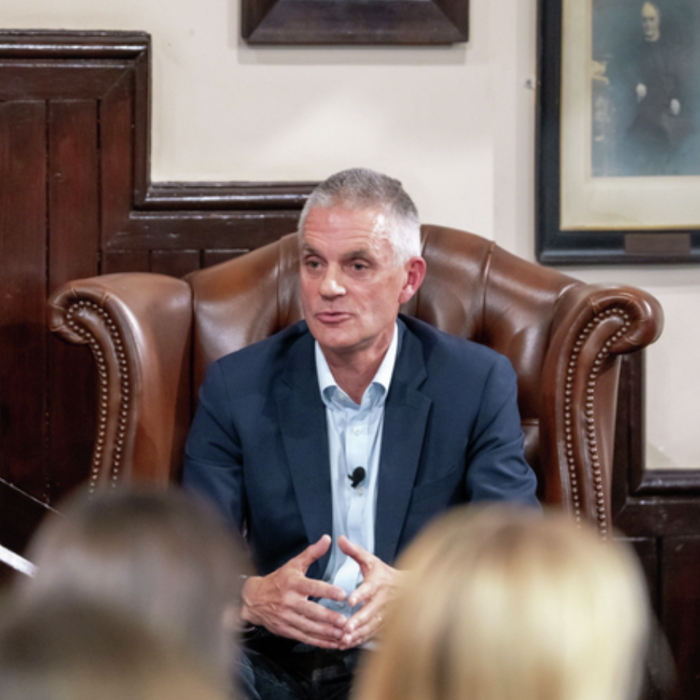‘At the heart of what we do is creativity’ – Tristram Hunt on running the V&A
The director of the V&A museum talks art, politics, and 9am lectures with Seyan Dattani

Does the director of the Victoria and Albert Museum have the best office in Britain? As Tristram Hunt pours out a cup of tea (from a beautiful Staffordshire tea set, of course), I admire a magnificent oil painting of Prince Albert by Godfrey Sykes, which served as a preparatory study for a commemorative mosaic of the Prince approved by Queen Victoria herself.
Hunt’s passions for art and history were early ones. His artist grandfather lived in Chelsea and he fondly remembers coupling childhood trips to the London Boat Show in Earl’s Court with visits to the V&A. As a child, he was awed by the Cast Courts, a gallery containing 19th-century replicas of famous classical and Renaissance works, including Trajan’s Column and Raphael’s School of Athens. To Hunt, the Courts are the “beating heart” of the museum: “there’s a sense [not just] of the sublime… but also the technology of the Victorians in recreating them.”
“history is not just one bloody thing after another - it has to teach you critical analysis”
His interest was nurtured by two “brilliant” history teachers, Mr McIntosh and Mr Morris, who taught him about Friedrich Engels and the condition of the English working class. Remembering endless GCSE essays on Weimar Germany, I ask whether today’s history curriculum is too narrow. Hunt disagrees - citing his children, who have studied “South Asia, the colonisation of America and the transatlantic slave trade,” he thinks the syllabus is actually richer and broader than it ever has been. He also argues that history teaching should also focus on developing transferable skills: “history is not just one bloody thing after another - it has to teach you critical analysis.”
Hunt read History at Trinity, his father’s old college, and quickly became something of a polymath. He was Varsity’s gossip columnist and joined the Footlights, where he rubbed shoulders with Mitchell and Webb, Ali G writer Dan Mazer, and Olivia ‘Collie’ Colman (“Collie was great!”). One thing he never did, however, was visit the Fitzwilliam Museum, a mistake he urges Varsity readers not to repeat. “It has the most incredible collection, is run by a brilliant director and has really challenging exhibitions,” adding that, along with Kettle’s Yard and the Museum of Archaeology and Anthropology, it is “a great place to grow your understanding.”
Unlike many of my historian friends (not naming any names!), Hunt was often up for Quentin Skinner’s 9am lectures on the history of political thought. “It was like a Netflix series,” he remembers, “except, if you missed one, you were in real bloody trouble because he didn’t do a recap!” Hunt stayed at Cambridge for his PhD on civic thought in the 19th century and fondly remembers intellectual conversations with his flatmate, future Chancellor Kwasi Kwarteng (then pursuing a doctorate on the Recoinage Crisis of 1681). “Kwasi moves at fast speeds,” Hunt recalls wryly, which meant he “didn’t really gel” with his more ponderous supervisor, economic historian Istvan Hont.
Like Kwarteng, Hunt would soon enjoy a glittering political career. Fittingly, he became the Labour MP for Stoke-on-Trent - a city synonymous with Britain’s pottery industry and its godfather, Josiah Wedgwood. When the Wedgwood collection was at risk of sale, Hunt led a coalition to rescue the collection for the nation, setting up what is now the V&A Wedgwood Collection in Staffordshire.
From buy-one-get-one-free to the use of influencers, Hunt rattles off some of the business practices introduced or popularised by Wedgwood. Would the world be a different place without the legendary potter? In true historian fashion, he is not so sure: “Wedgwood emerged from a historical context in which there were other actors not a million miles away.”
“We celebrate and interrogate the maker”
Hunt became an unusually intellectual and cultured figure in British politics but eventually found the powerlessness of opposition immensely frustrating. He eventually quit the parliamentary party during Jeremy Corbyn’s ill-fated tenure (“I was almost as opposed to him as I was to the Tories!” he laughs) to take up his present role at the V&A.
In a world where they are often criticised for their colonial histories, Hunt remains a passionate advocate for the ‘world museum’. He believes questions of restitution should be treated with nuance and has instead spearheaded a system of long-term loans, including looted Asante gold to Ghana and a gold ewer to Turkey. Hunt adds that the areas of contestation are far smaller than the media makes out and ultimately concludes “we’re a museum, not of colonialism, but of art, design and performance.”
It’s these foci that distinguish the V&A from other national collections. Unlike, say, the British Museum (“essentially a museum of civilisations”), the V&A “doesn’t do antiquities… the vast majority of our material is post 1000 AD”. Nevertheless, its fashion, photography and ceramics collections all rank among the finest in the world. “We celebrate and interrogate the maker,” says Hunt, “and at the heart of what we do is creativity”.
Although Hunt once wrote an article arguing for museums to charge entry fees, he no longer believes this is the right approach for national museums such as the V&A. “If you start charging, you lose 50% of your audience,” he says, pointing to the sums spent by visitors in the museum’s shops, cafés and exhibitions. Nevertheless, he remains concerned by the situation outside London. Blaming a “terrible funding settlement” agreed under the last government, Hunt argues that regional museums have been starved of cash in recent years and that, for some of them, charging for entry may be the only option available.
We finish by discussing the museum’s recent exhibitions on figures from pop culture, such as Taylor Swift. Is there an inherent tension between the museum’s commitment to art and highbrow culture and the need to appeal to the masses? Hunt doesn’t think so, citing the V&A’s origin out of the wildly popular 1851 Great Exhibition. “Right from the beginning, there’s been this strong synergy with commerce and wealth creation,” he says, “we’ve never been afraid to bring the public in - as long as it’s done in an exciting, scholarly and interesting way.”
 News / SU reluctantly registers controversial women’s soc18 December 2025
News / SU reluctantly registers controversial women’s soc18 December 2025 Features / Should I stay or should I go? Cambridge students and alumni reflect on how their memories stay with them15 December 2025
Features / Should I stay or should I go? Cambridge students and alumni reflect on how their memories stay with them15 December 2025 News / Dons warn PM about Vet School closure16 December 2025
News / Dons warn PM about Vet School closure16 December 2025 News / Cambridge study finds students learn better with notes than AI13 December 2025
News / Cambridge study finds students learn better with notes than AI13 December 2025 News / Uni registers controversial new women’s society28 November 2025
News / Uni registers controversial new women’s society28 November 2025










